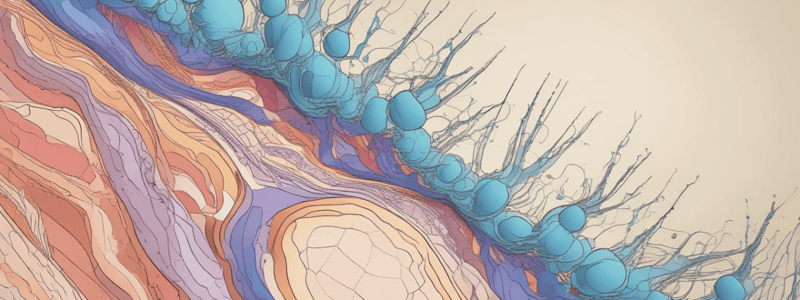Podcast
Questions and Answers
What is the number of transmembrane segments in a major facilitator superfamily integral membrane protein?
What is the number of transmembrane segments in a major facilitator superfamily integral membrane protein?
12
What is the structural arrangement of the α-helices in the glucose transporter?
What is the structural arrangement of the α-helices in the glucose transporter?
4-5 amphipathic α-helices are packed to form a hydrophilic channel
What is the mechanism by which glucose transport occurs in GLUT1?
What is the mechanism by which glucose transport occurs in GLUT1?
Gated Pore Mechanism
How many GLUT family members exist in the human genome?
How many GLUT family members exist in the human genome?
What is the primary function of GLUT1 in erythrocytes?
What is the primary function of GLUT1 in erythrocytes?
What is the superfamily of sugar transporters that GLUTs belong to?
What is the superfamily of sugar transporters that GLUTs belong to?
What is the main function of GLUT1?
What is the main function of GLUT1?
In cases of defective GLUT1, why do patients present with brain-related symptoms?
In cases of defective GLUT1, why do patients present with brain-related symptoms?
Explain why a ketogenic diet is standard care for patients with defective GLUT1.
Explain why a ketogenic diet is standard care for patients with defective GLUT1.
What is the role of GLUT2 in the liver and kidney?
What is the role of GLUT2 in the liver and kidney?
How does GLUT4 respond to high blood glucose levels in adipocytes?
How does GLUT4 respond to high blood glucose levels in adipocytes?
What happens to GLUT4 transporters when insulin levels decrease?
What happens to GLUT4 transporters when insulin levels decrease?
What is the main function of SERCA pumps?
What is the main function of SERCA pumps?
How does the E1 conformation of SERCA differ from E2?
How does the E1 conformation of SERCA differ from E2?
What is the role of Plasma membrane Ca+2-ATPase? (PMCA)
What is the role of Plasma membrane Ca+2-ATPase? (PMCA)
How does Na+K+ ATPase of the plasma membrane move ions across the membrane?
How does Na+K+ ATPase of the plasma membrane move ions across the membrane?
What can inhibit the Na+K+ ATPase of the plasma membrane?
What can inhibit the Na+K+ ATPase of the plasma membrane?
How much of the energy (ATP) used by cells goes towards the function of the Na+K+ ATPase?
How much of the energy (ATP) used by cells goes towards the function of the Na+K+ ATPase?
How does Digitoxigenin, an inhibitor of Na+/K+ ATPase, stimulate cardiac contraction?
How does Digitoxigenin, an inhibitor of Na+/K+ ATPase, stimulate cardiac contraction?
What is the main function of V-Type ATPases?
What is the main function of V-Type ATPases?
What is the difference between F0 and F1 in F-type ATPases?
What is the difference between F0 and F1 in F-type ATPases?
What is the role of ABC ATPases?
What is the role of ABC ATPases?
What is the function of F-type ATPases in mitochondria and chloroplasts?
What is the function of F-type ATPases in mitochondria and chloroplasts?
What is the common feature of ABC ATPases?
What is the common feature of ABC ATPases?
What is the main difference between primary active transport and secondary active transport?
What is the main difference between primary active transport and secondary active transport?
What is the role of P-type ATPases in primary active transport?
What is the role of P-type ATPases in primary active transport?
What is the source of energy for primary active transport?
What is the source of energy for primary active transport?
What is the significance of maintaining low cytoplasmic Ca+2 levels?
What is the significance of maintaining low cytoplasmic Ca+2 levels?
What is the common structural feature of all P-type ATPases?
What is the common structural feature of all P-type ATPases?
What is the physiological role of the erythrocyte Anion Exchange Protein (AE1)?
What is the physiological role of the erythrocyte Anion Exchange Protein (AE1)?
What type of exchange does the Band 3 Transporter (AEP) perform?
What type of exchange does the Band 3 Transporter (AEP) perform?
Why is the coupling of Cl- and HCO3- considered obligatory in the AE system?
Why is the coupling of Cl- and HCO3- considered obligatory in the AE system?
Where is the enzyme that converts CO2 to HCO3- located in the red blood cell?
Where is the enzyme that converts CO2 to HCO3- located in the red blood cell?
How many times does the AEP span the membrane?
How many times does the AEP span the membrane?
what does ABCB1 (gene) encode for?
what does ABCB1 (gene) encode for?
Which ABC transporter is known as P-glycoprotein 1 and plays a role in multidrug resistance in humans?
Which ABC transporter is known as P-glycoprotein 1 and plays a role in multidrug resistance in humans?
What is the function of the ABCG2 transporter?
What is the function of the ABCG2 transporter?
Which ABC transporter is known as the cystic fibrosis transmembrane conductance regulator protein?
Which ABC transporter is known as the cystic fibrosis transmembrane conductance regulator protein?
What is the significance of Multidrug transporter (MDR1), also known as ABCB1, in human organisms?
What is the significance of Multidrug transporter (MDR1), also known as ABCB1, in human organisms?
How does the Cystic Fibrosis Transmembrane conductance Regulator Protein (CFTR) transport ions?
How does the Cystic Fibrosis Transmembrane conductance Regulator Protein (CFTR) transport ions?
what is the enzyme that converts co2 to HCO3- called
what is the enzyme that converts co2 to HCO3- called
which ABC gene is defective/mutated in tangier disease
which ABC gene is defective/mutated in tangier disease
what is the role of ABCA1
what is the role of ABCA1
What is the target for treatment of diabetes that Gliflozins inhibit in the kidney?
What is the target for treatment of diabetes that Gliflozins inhibit in the kidney?
What type of channels are K+-channels in mammals?
What type of channels are K+-channels in mammals?
Where are bacterial porins typically found?
Where are bacterial porins typically found?
What is the minimum number of β-strands required to form a barrel in bacterial porins?
What is the minimum number of β-strands required to form a barrel in bacterial porins?
What is the structural basis for voltage-gating in K+-channels?
What is the structural basis for voltage-gating in K+-channels?
What is the general role of SGLT2 inhibitors in the treatment of type 2 diabetes?
What is the general role of SGLT2 inhibitors in the treatment of type 2 diabetes?
What is the quaternary structure of the ligand-gated Acetylcholine-receptor ion channel?
What is the quaternary structure of the ligand-gated Acetylcholine-receptor ion channel?
What is the mechanism by which Na+ selectivity is dictated in ligand-gated ion channels?
What is the mechanism by which Na+ selectivity is dictated in ligand-gated ion channels?
What are the competitive antagonists that block the ligand-gating of Acetylcholine-receptor ion channels?
What are the competitive antagonists that block the ligand-gating of Acetylcholine-receptor ion channels?
Which neurotransmitters trigger the opening of cation channels in ligand-gated ion channels?
Which neurotransmitters trigger the opening of cation channels in ligand-gated ion channels?
What is the essential principal subunit in mammalian channels and how many homologous domains does it have?
What is the essential principal subunit in mammalian channels and how many homologous domains does it have?
What drives the co-transport of lactose in E. coli's lactose permease (LacY) transporter?
What drives the co-transport of lactose in E. coli's lactose permease (LacY) transporter?
What happens to the transport function of LacY if cytochrome oxidase of the electron transport chain is inhibited by CN-?
What happens to the transport function of LacY if cytochrome oxidase of the electron transport chain is inhibited by CN-?
In eukaryotic cells, what ion gradient generated by the sodium-potassium ATPase drives the sodium-glucose symporter?
In eukaryotic cells, what ion gradient generated by the sodium-potassium ATPase drives the sodium-glucose symporter?
What provides the energy needed for the transport of glucose into eukaryotic cells by the sodium-glucose symporter?
What provides the energy needed for the transport of glucose into eukaryotic cells by the sodium-glucose symporter?
What is the role of the Na+-glucose symporter located on the apical surface of animals' intestines?
What is the role of the Na+-glucose symporter located on the apical surface of animals' intestines?
What is the main function of the glucose uniporter GLUT2 located on the basal surface of certain cells?
What is the main function of the glucose uniporter GLUT2 located on the basal surface of certain cells?
Which aquaporin is predominantly found in the lens and has low water permeability?
Which aquaporin is predominantly found in the lens and has low water permeability?
In which tissue is AQP7 predominantly found with high permeability to water, glycerol, and urea?
In which tissue is AQP7 predominantly found with high permeability to water, glycerol, and urea?
Where is AQP3 predominantly located with high permeability to water, glycerol, and moderate permeability to urea?
Where is AQP3 predominantly located with high permeability to water, glycerol, and moderate permeability to urea?
Which aquaporin is mainly distributed in the salivary gland, lacrimal gland, sweat gland, and has high water permeability?
Which aquaporin is mainly distributed in the salivary gland, lacrimal gland, sweat gland, and has high water permeability?
Where can AQP10 be found with low water permeability and high permeability to glycerol and urea?
Where can AQP10 be found with low water permeability and high permeability to glycerol and urea?
Which aquaporin is primarily located in the kidney, testis, liver, and pancreas, with high water permeability?
Which aquaporin is primarily located in the kidney, testis, liver, and pancreas, with high water permeability?





